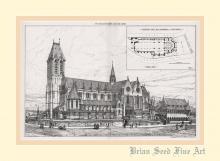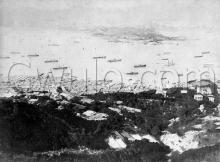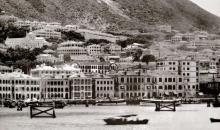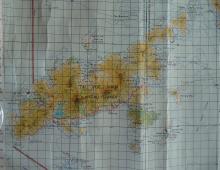Roman Catholic Cathedral (2nd & current location) [1888- ]
Primary tabs
Submitted by David on Thu, 2010-02-11 14:49
Current condition:
In use
Date Place completed:
1888-12-07
The first Roman Catholic Cathedral in Hong Kong stood on Wellington Street.
Key dates for this, the second Roman Catholic Cathedral:
- 1883 The foundation stone was laid on the Feast Day of Immaculate Conception, 8 December 1883.
- 1888 The Cathedral was completed at a cost of US$15,400 and opened to the public on 7 December 1888.
- 1937 The central spire was destructed during a typhoon.
- 1938 The Cathedral and the three altars (the main altar, the Sacred Heart altar and the St. Joseph altar), were consecrated by the Vicar Apostolic of Hong Kong, the Bishop of Macau and the Bishop Emeritus of Guangzhou.
- 1941 Damage by a shell dropped by the Japanese on 8 December 1941.
- 1947 The campanile [a free-standing bell tower] in front of the Cathedral was demolished for building a school.
- 1949 The pipe organ was repaired with new parts from Italy.
- 1950 Roof repair at a cost of US$3,200 with a donation from Mr. Tang King Po.
- 1952 The central dome was replaced by the present tower. The roof over the aisle, transepts and St. Joseph altar were rebuilt. The dado of the Cathedral was decorated with carved timber panels and the floor was laid with green and white tiles.
- 1958 A five-storeys church office building was built next to the Cathedral.
- 1969 Internal layout was re-arranged with the liturgical reform after the Vatican II Eccumenical Council . The position of the Main altar was moved to the centre, i.e. at the intersection of the nave and transepts under the central tower.
- 1985 A niche was constructed over the door of the sacristy for the statue of the Immaculate Virgin to whom the Cathedral is dedicated. Four large Italian stained glass windows depicting the four Evangelists were installed at the east side of the Main altar.
- 1988 Large scale renovation to celebrate the Centenary of the Cathedral was carried out by Rocco Design Limited. The roof structure was repaired, by grouting and air-conditioning was introduced.
Taken from the UNESCO award document describing the conservation of the cathedral. (Thanks to Moddsey for the link.)
Tags:





Comments
1899 - Roman Catholic Cathedral of the Portuguese
"The imposing Roman Catholic Cathedral of the Portuguese; a smaller chapel for the English Roman Catholic worshippers (Ed: St. Joseph's)"
Hong Kong chapter by Dr. James Cantlie
(British Empire Series Volume 1, 1899)
Photo c.1897
re Roman Catholic Campanile
Taken not long before its demolition in 1947 I guess. you can see it's missing its shutters and glass in windows
http://via.lib.harvard.edu/via/deliver/deepLink?_collection=via&recordId...
1880 Building Plan
Title: The Building News 1880 Proposed New R.C Cathedral - Hong Kong
Year: 1880
Condition: Fine
Type: Lithograph
Colour: Uncoloured
Area Shown: Hong Kong
Engraved Area: 15.625 x 10.375 inches /39.7 x 26.4 cm
Item info:
Issued in the Building News Dec 24th 1880. View and General Plan of the proposed new R.C Cathedral - Hong Kong. Lithographed and Printed by James Alerman, 6 Queen Square, W.C, London. History of The Hong Kong Catholic Cathedral of the Immaculate Conception : The first Roman Catholic cathedral of Hong Kong was built in 1843 on Wellington Street and destroyed in a fire in 1859. The cathedral was rebuilt, but subsequently a different site was selected just above Caine Road by the Glenealy Ravine, where it is still located today. The Cathedral was designed by Crawley and Company of London. Construction of the new building started in 1883. Services first began in July 1886 under the auspices of the Apostolic Vicar Dominic Pozzoni and the first Mass was celebrated on 7 December 1888.
The belfry / bell-tower / campanile
We know the tower was demolished in 1947, and I'd imagined it had been damaged during the war, possibly by a stray bomb. So I was interested to read this explanation of what happened:
In 1888 when Bishop T Raimondi, the PIME, and other PIME missionaries built the cathedral in Hong Kong, they faithfully followed the Catholic tradition of adding a belfry. Next to the church's main entrance they built a 150 foot high, imposing belltower housing a set of melodious spells imported from Italy. The belfry was to be a visible and highly audible symbol of the presence of Christ in the midst of "pagan" Hong Kong.
Little did they know that 54 years later those bells would be requisitioned by the Japanese and melted into arms and ammunition to kill the Chinese. Also, they never foresaw that the wooden structure supporting the numerous bells would one day be quite literally converted to rice to save many people from starvation.
During the occupation, cooking fuel was a rare and expensive commodity in Hong Kong because there was no coal, nor gas, firewood. Bishop Valtorta, with the full consent of the community, decided to demolish the belfry and sell the beams as firewood. The proceeds of that sale gave us and many of our poor people "daily rice" for many months.
When the money from the sale of the belfry was exhausted, there was nothing else to sell but a few gold chalices and other valuable religious articles that had been donated to the parish through the years. They were kept in a safe in the Bishop's office. Every three or four weeks, when he was alone, good Bishop Valtorta would open the safe, and with much hesitation choose a golden paten, or the gold cup of a chalice or a ciborium, to be sold. After he had made his choice, he would carefully hide it under his cassock and slowly walk downtown to sell it ounce by ounce to a Japanese shop, after endless haggling about the value. Then, pale and haggard, he would return to the cathedral and give all the money to the administrator, Fr. E. Bruzzone. In those days, selling gold involved a great deal of personal risk because of the many spies and robbers, and Bishop Valtorta preferred to risk his own life rather than endanger any of his priests.
Pages 267-8 of China: Lost mission? by Nicholas Maestrini.
Regards, David
The Roman Catholic Cathedral
Some notes from a visit to the cathedral last month:
Thanks to Geoff Emerson for arranging the visit, and to Father Louis Ha for showing us around.
Regards, David
Cathedral belfry
Thank you David,
Well it all fits in. Built 1888, damaged 1941, bells confiscated 1942 - 54 years later as described by Fr Maestrini. He could have been a bit clearer by adding that as the structure was damaged and the Japanese taken taken the beels, the.wooden internals sold off for firewood during the wear. Seems like a long time for the ruins to be demolished. Anyway it satisfied my curiosity as to why I did not recall seeing thehigh belfry, I definitely recall playing around the base of it as went went to Mass in the Cathedral.
I obviously have to explore more of Gwulo. It certainly has grown considerably from when I first came across your site many years ago. You were then explaining how to use the Public Library's MMIS. I tried your suggestion of Alternatiff, but didn't have much luck.
Best wishes
John